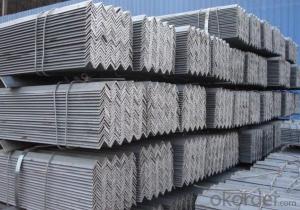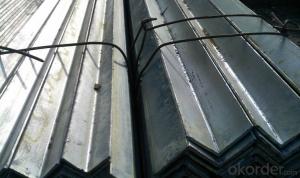Angle steel high quality
- Loading Port:
- China Main Port
- Payment Terms:
- TT OR LC
- Min Order Qty:
- -
- Supply Capability:
- -
OKorder Service Pledge
OKorder Financial Service
You Might Also Like
Product Description:
Stainless Steel Angles
1.Grade: SS200,300,400 series
2.Size: 25×25×3 mm-100×100×10mm
3.Process: HRAP
4. Length: 2-6m
5. Shape: Equal
6. Delivery: within 20 days
7. MOQ: 1 ton
8. Certificate: ISO 9001:2008, SGS
9. Package:Standard Export Packing, or put into wooden boxes according to your
requirement
10. Application: Construction, Marine, Industry and so on
Name | Stainless Steel Angles | ||||||
Standard | ASTM A554, A312, A249, A269 and A270 | ||||||
Material Grade | 304,316,201,202, 316L,430 | ||||||
Length | 6m or as customers' request | ||||||
Tolerance | a) thickness: +/-0. 15mm | ||||||
| |||||||
b) Length:+/-4. 5mm - 0mm | |||||||
Surface | 180G, 320G, 400G Satin / Hairline(Matt Finish, Brush, Dull Finish) 400G, 500G, 600G or 800G Mirror finish | ||||||
Application | Decoration construction, upholstery, industry instruments | ||||||
Test | Squash test, Extended test, Water pressure test, Crystal rot test, Heat treatment, NDT | ||||||
Chemical Composition of Material |
Composition
Material | 201 | 202 | 304 | 316L | 430 | |
C | ≤0.15 | ≤0.15 | ≤0.08 | ≤0.08 | ≤0.12 | ||
Si | ≤1.00 | ≤1.00 | ≤1.00 | ≤1.00 | ≤1.00 | ||
Mn | 5.5-7.5 | 7.5-10 | ≤2.00 | ≤2.00 | ≤1.00 | ||
P | ≤0.06 | ≤0.06 | ≤0.045 | ≤0.045 | ≤0.040 | ||
S | ≤0.03 | ≤0.03 | ≤0.030 | ≤0.030 | ≤0.030 | ||
Cr | 16-18 | 17-19 | 18-20 | 16-18 | 16-18 | ||
Ni | 3.5-5.5 | 4-6 | 8-10.5 | 10-14 |
| ||
Mo |
|
|
| 2.0-3.0 |
| ||
Mechanical Property | Material Item | 201 | 202 | 304 | 316L | ||
Tensile Strength | ≥535 | ≥520 | ≥520 | ≥520 | |||
Yield Strength | ≥245 | ≥205 | ≥205 | ≥205 | |||
Extension | ≥30% | ≥30% | ≥35% | ≥35% | |||
Hardness (HV) | <253 | <253 | <200 | <200 | |||
- Q: Are steel angles available in non-standard dimensions?
- Yes, steel angles are available in non-standard dimensions.
- Q: Can steel angles be used in high-rise or multi-story buildings?
- Yes, steel angles can be used in high-rise or multi-story buildings. They are commonly utilized in construction due to their strength, versatility, and ability to provide structural support. Steel angles are often used for framing, bracing, and reinforcing various components of the building, such as walls, floors, and beams. Their use in high-rise or multi-story buildings helps ensure stability, durability, and load-bearing capacity.
- Q: How do you determine the appropriate size of steel angle for a specific application?
- To determine the appropriate size of steel angle for a specific application, factors such as the load it needs to bear, the length of the span, the type of material being supported, and any applicable building codes or regulations should be considered. Structural engineers or professionals with expertise in steel construction can perform calculations and analysis to determine the required size of steel angle based on these factors.
- Q: How do you store steel angles to prevent damage?
- Steel angles can be stored to prevent damage by ensuring they are stored in a dry, well-ventilated area, preferably indoors. They should be stacked on a flat surface and separated by wooden or rubber spacers to avoid direct contact and potential scratching. Additionally, storing them in an organized manner, with heavier angles at the bottom and lighter ones on top, can help prevent any potential bending or warping.
- Q: Can steel angles be used for manufacturing storage racks?
- Yes, steel angles can be used for manufacturing storage racks. Steel angles are strong and durable, making them suitable for supporting heavy loads in storage rack systems. Additionally, their shape allows for easy assembly and customization of storage rack designs.
- Q: What are the different methods for reinforcing steel angles?
- There are several methods for reinforcing steel angles, including welding additional steel plates or bars to the angle to increase its strength and stability, using brackets or gussets to provide additional support, and using adhesive bonding agents or epoxy coatings to enhance the bond between the angle and the surrounding structure. These methods help to ensure that the steel angle can withstand higher loads and provide better resistance against bending or twisting forces.
- Q: What is the minimum thickness for a steel angle bracket?
- The minimum thickness of a steel angle bracket depends on its specific application and the load it is meant to bear. Typically, a thickness of 1/8 inch (3.175 mm) is commonly employed for angle brackets, providing ample strength and rigidity to withstand normal loads and forces. However, it is crucial to bear in mind that for heavier loads or specialized uses, thicker steel brackets may be necessary to guarantee structural integrity and safety. It is advisable to seek the advice of a structural engineer or adhere to industry standards and guidelines to ascertain the suitable minimum thickness for a steel angle bracket in a particular application.
- Q: Can steel angles be used in HVAC ductwork?
- Yes, steel angles can be used in HVAC ductwork. Steel angles are commonly used in ductwork to provide structural support and reinforcement. They are typically used at corners and joints to strengthen the ductwork and maintain its shape. Steel angles are durable, strong, and resistant to corrosion, making them suitable for use in HVAC ductwork systems. Additionally, steel angles can be easily welded or fastened together, allowing for easy installation and customization. Overall, steel angles are a reliable and commonly used component in HVAC ductwork systems.
- Q: How do you calculate the load-bearing capacity of a steel angle?
- To calculate the load-bearing capacity of a steel angle, you need to consider factors such as the dimensions of the angle, the material properties of the steel, and the type of loading it will experience. The load-bearing capacity can be determined using engineering formulas or reference tables that take into account the angle's cross-sectional area, moment of inertia, and the yield strength of the steel. Additionally, structural design codes and standards should be consulted to ensure the calculated load-bearing capacity meets the required safety factors and regulations.
- Q: What are the alternatives to steel angles in construction?
- There are several alternatives to steel angles in construction that offer different advantages and disadvantages depending on the specific application. 1. Aluminum angles: Aluminum angles are lightweight and corrosion-resistant, making them a popular choice for outdoor construction projects. They are also easily machinable and have good electrical conductivity. However, aluminum angles may not have the same strength and load-bearing capacity as steel angles, making them less suitable for heavy-duty structural applications. 2. Fiberglass angles: Fiberglass angles are lightweight, non-conductive, and highly resistant to corrosion and chemical damage. They are commonly used in industries where exposure to harsh environments, such as water or chemicals, is a concern. However, fiberglass angles may not have the same strength as steel angles and may require additional reinforcement for heavy loads. 3. Carbon fiber angles: Carbon fiber angles are lightweight, high-strength, and have excellent resistance to corrosion. They are commonly used in applications where weight reduction is critical, such as aerospace and automotive industries. However, carbon fiber angles tend to be more expensive than steel angles and may require specialized manufacturing techniques. 4. Wood angles: Wood angles, typically made from hardwood or engineered wood products, are a traditional alternative to steel angles in construction. They are readily available, cost-effective, and easy to work with. Wood angles are often used in residential and light commercial construction projects. However, wood angles may not have the same strength and durability as steel angles and may be more prone to warping, cracking, or rotting over time. It's important to consider the specific requirements of the construction project, including the load-bearing capacity, environmental conditions, and budget, when choosing an alternative to steel angles. Consulting with a structural engineer or construction professional can help determine the most suitable option for each specific scenario.
Send your message to us
Angle steel high quality
- Loading Port:
- China Main Port
- Payment Terms:
- TT OR LC
- Min Order Qty:
- -
- Supply Capability:
- -
OKorder Service Pledge
OKorder Financial Service
Similar products
Hot products
Hot Searches
Related keywords




























